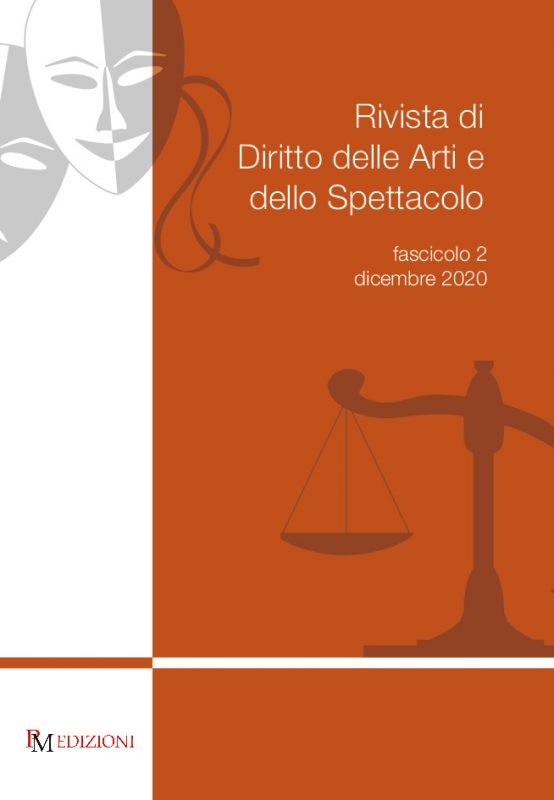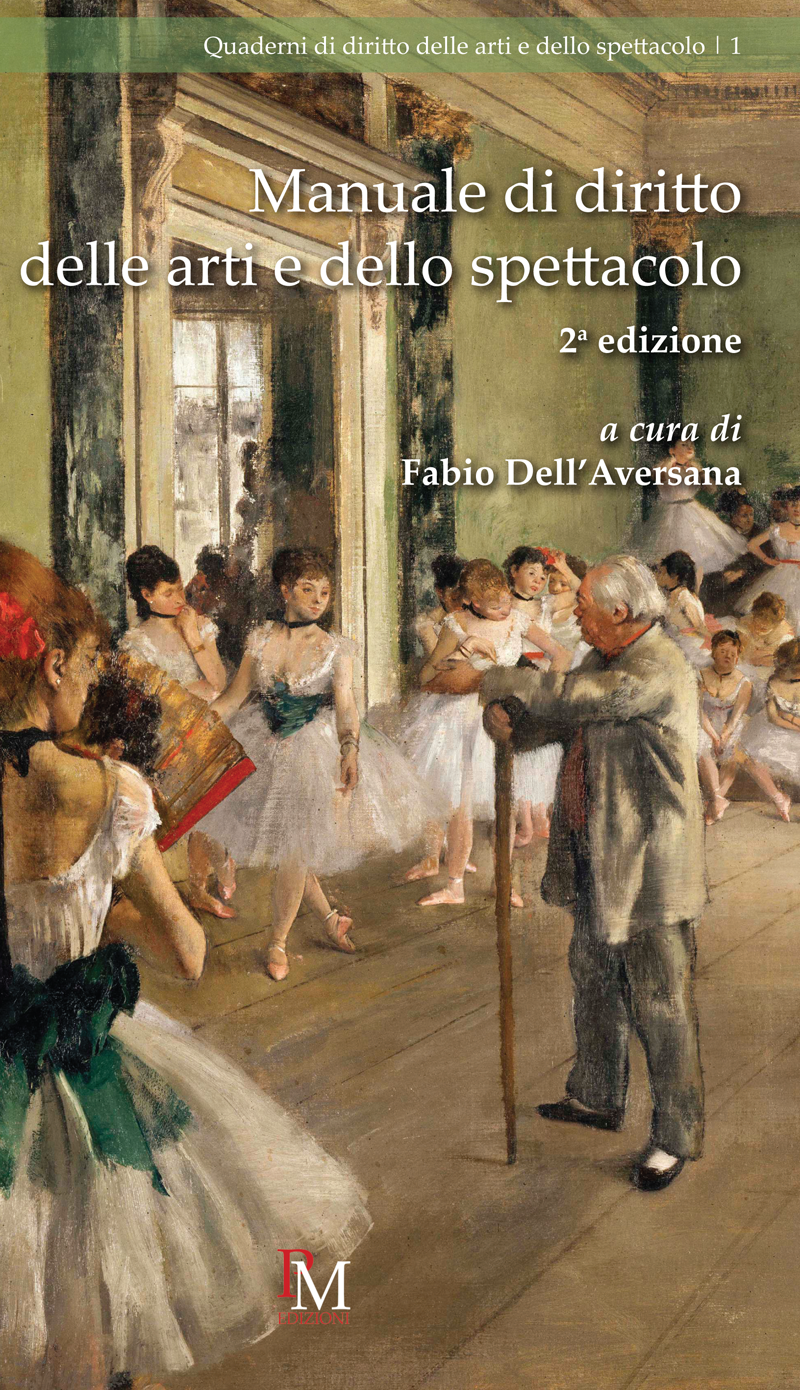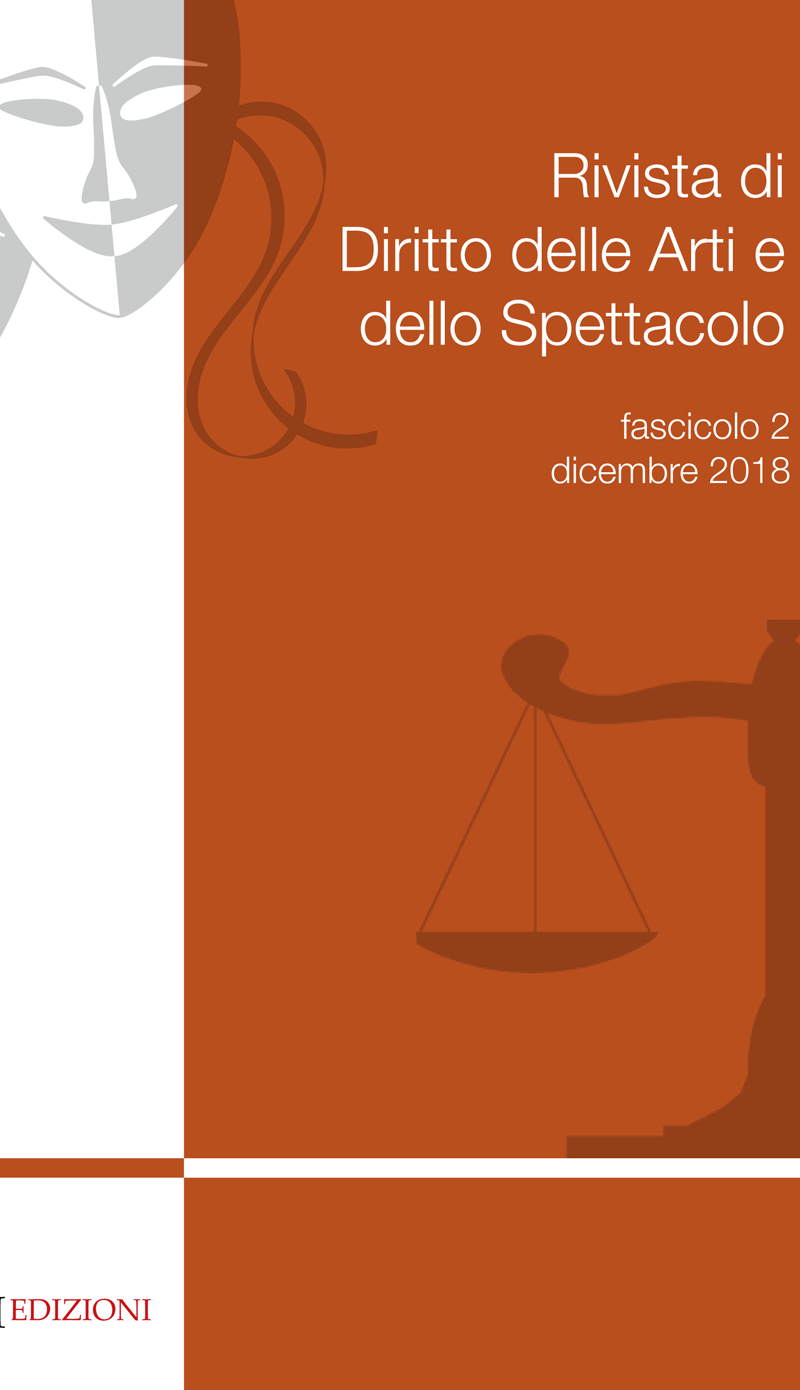Rivista di diritto delle arti e dello spettacolo
Fascicolo 2/2020
Rivista fondata per analizzare, nella prospettiva giuridica ed economica, i problemi del mondo delle arti e dello spettacolo, caratterizzata da un approccio multidisciplinare e trasversale allo studio della materia.
scarica l'editoriale completo
Abstract 🇮🇹 🇬🇧
Italiano
Si discute da decenni se gli oggetti industriali possano essere protetti dal diritto d’autore, in aggiunta o indipendentemente dalla sua tutela dalla legge sul disegno industriale e, se del caso, dal diritto di marchi e dei brevetti. La questione acquista una dimensione specialmente rilevante in relazione alle creazioni nel mondo della moda e accessori, che costituiscono una parte importante di questa nuova disciplina nota come “fashion law”.
Abstract ”Dove sono i bei momenti” – un’aria della Contessa ne Le nozze di Figaro di Mozart (atto III.8) – è un capolavoro che racconta di rimpianti, ricordi di un amore perduto, ma anche fiducia nel futuro. Questo è, senza dubbio, uno dei vertici de Le nozze di Figaro, e una delle più intense e musicalmente raffinate creazioni dell’intera tradizione lirica. Dopo aver rievocato, con accenti di profondo rammarico, il passato amore per il marito ormai infedele, la contessa attende con impazienza le possibilità di recuperare, da raggiungere con impegno e perseveranza. La nostalgia, memorie perdute, ricordi del passato, insieme alla speranza di una ripresa sono sentimenti comuni che gli amanti dell’opera e gli habitués condividono a causa dell’impatto della pandemia da COVID-19 sta ancora avendo su tutte le performance artistiche, e in particolare sulla Opera house del Globe. La crisi pandemica è uno shock senza precedenti per tutti i settori, compresi teatri, sale da concerti, show musicali e performance di ogni genere. Dalle prime vittime – quando il World Health Organization (WHO) ha identificato, nel dicembre 2019 la prima epidemia a Wuhan, China – il virus si è rapidamente diffuso in tutto il mondo, portando i governi a chiedere lockdown generali, la chiusura di tutte le attività non essenziali al fine di prevenire la diffusione incontrollata del virus e il collasso dei sistemi sanitari. Non sorprende il fatto che questo abbia colpito profondamente anche i teatri d’opera e i teatri – così come ogni altro tipo di raduno, evento o festival – che hanno dovuto chiudere forzatamente, sospendendo così l’intero calendario degli eventi e lasciando gli artisti a casa senza lavoro. Gli impatti culturali e le conseguenze di questa situazione non possono essere sottovalutati, e naturalmente va ben oltre le forme e le rappresentazioni artistiche. Lo scopo di questo articolo è duplice: (i) nelle Sezioni I e II forniremo ampie prove e documentazione su come i teatri d’Opera abbiano affrontato le misure legate alla pandemia che i governi di tutto il mondo hanno dovuto adottare, come sono cambiati i loro modelli di business per offrire ancora un programma in qualche modo simile attraverso lo streaming e le nuove tecnologie, nonché la successiva, seppur breve, ripresa di alcuni eventi durante l’estate 2020. A questo proposito, l’analisi distinguerà tra il primo (primavera-estate 2020) e il secondo lockdown (autunno-inverno 2020), e si concentrerà su alcuni dei più prestigiosi teatri d’opera di tutto il mondo, con un focus più attento sulla risposta fornita dalle sale italiane fino al 31 dicembre 2020. Lo scopo di queste due Sezioni è quello di fornire un quadro, e al tempo stesso storicizzare, l’esperienza unica, anche se in qualche modo drammatica, dei teatri dell’Opera durante la pandemia del 2020, esponendo cifre e, in sostanza, raccontando fatti; (ii) nella Sezione III, verranno tratteggiate alcune riflessioni preliminari sul piano estetico e culturale l’impatto di questa esperienza unica, anche se drammatica, comprese le riflessioni sul dibattito di lunga data su spettacoli dal vivo, streaming, diffusione on-line di musica. Alla fine, seguiranno alcune brevi conclusioni.
Keywords: Opera – Musical theatre – Mediatization – Live streaming – Performance studies.
Abstract I due autori, muovendo da posizioni e da esperienze radicalmente diverse, dialogano sul modello organizzativo delle istituzioni dell’alta formazione artistica nel nostro Paese ad oltre un ventennio dalla legge di riforma e in occasione di una prossima attesa revisione dei regolamenti di autonomia. L’AFAM, al pari della Sagrada Familia di Gaudì, è un “cantiere” o ancor meglio una “fabbrica” in perenne e costante divenire. Cifra stilistica del genere è l’instabilità normativa e l’incompiutezza di una tela che con non poca difficoltà il restauratore migliore può proporsi di affrontare, il ricorso all’analogia è dunque d’obbligo. Nondimeno, seguendo la via maestra indicata dalla Costituzione, gli Autori suggeriscono di colmare le lacune del sistema traendo il meglio dal paradigma universitario “tolto il troppo e il vano”. Consci tuttavia dell’imperfezione dello stesso modello ideal-tipico propongono di usare le istituzioni AFAM come laboratorio di un diverso modello possibile di governance che nello specifico possa preservare, razionalizzandolo, il sistema duale imperniato sulle figure del direttore e del presidente (del CDA) delle istituzioni AFAM attraverso una reciproca specializzazione – ad oggi in parte vanificata dalla sostanziale coincidenza per via pretoria delle condizioni di accesso alle cariche, almeno nel caso del Direttore – che si limita a positivizzare un dato ormai fatto proprio dal sistema.
Parole chiave: autonomia – AFAM – governance – CEDU – dualismo.
Abstract Giorgio de Chirico e le sue opere costituiscono l’elemento unificante dell’indagine che tende alla evidenziazione del suo impatto sulla dottrina e la giurisprudenza. In particolare lo studio verte sul tema della circolazione delle opere di de Chirico e delle sue connessioni con le questioni relative alla autenticità dei quadri, della veridicità delle dichiarazioni di autentica rese dall’artista o dal gallerista, alla decorrenza dei termini di prescrizione ed infine al problema relativo alla possibile tassazione delle plusvalenze.
Parole chiave: De Chirico – quadri – falsi – prescrizione – plusvalenza.
Abstract La lettura della recente monografia di Giampaolo Frezza induce ad alcune riflessioni in merito al rapporto fra diritto e arte nonché al problema del diritto di autentica dell’opera d’arte e della tutela delle relative situazioni giuridiche soggettive. La tematica è certamente di attualità alla luce della rilevanza economica del mercato dell’arte e della rilevante incertezza in merito all’esistenza di un diritto all’accertamento giudiziale dell’autenticità dell’opera. La peculiarità della trattazione contenuta nella monografia oggetto di considerazione deriva dal fatto che l’Autore, constatata l’esistenza di una nutrita giurisprudenza che nega l’ammissibilità dell’azione di accertamento dell’autenticità dell’opera, sulla base del fatto che le azioni di accertamento possono avere ad oggetto solo diritti e non anche fatti, da un lato propone un’interpretazione costituzionalmente orientata dell’azione di accertamento e, dall’altro lato, identifica, quale oggetto di tutela della stessa azione, l’interesse del titolare di una situazione di proprietà sull’opera «nella sua accezione non già strutturale ma funzionale».
Parole chiave: opera d’arte – autenticità – azione di accertamento – certificato – ente certificatore.
Abstract Il primato dell’idea sulla forma, che caratterizza l’opera d’arte contemporanea, pone in discussione l’impianto dogmatico su cui è strutturato il diritto d’autore. Il presente contributo si propone di passare in rassegna talune peculiari manifestazioni artistiche della contemporaneità, evidenziando la persistente tenuta delle categorie giuridiche tradizionali.
Parole chiave: Opera d’arte contemporanea – tutela autoriale – forma espressiva – arte appropriativa – liceità
Abstract Ai diritti connessi la letteratura giuridica ha concesso, sinora, uno spazio marginale rispetto agli studi sul diritto d’autore, e ancor minori ricerche sono state effettuate sulle origini di tali diritti nella fase antecedente alla Convenzione di Roma, pietra angolare della disciplina. Eppure, l’iter che ha portato alla stesura di tale Carta, nel 1961, è stato solo l’apice di un percorso di richieste che per gli oltre trent’anni precedenti sono portate avanti da musicisti, discografici ed enti internazionali. Il presente lavoro mira a ricostruire le istanze delle associazioni di musicisti, per proteggere la categoria in conseguenza dell’utilizzo sempre più accentuato delle registrazioni musicali su vinile, nonché le pressioni dell’industria discografica per l’introduzione di un diritto di remunerazione per le trasmissioni radiofoniche dei fonogrammi di loro proprietà, per poi analizzare come tali sollecitazioni si siano incrociate con i primi enti internazionali, desiderosi di affermare la loro autorevolezza – col clima politico dell’epoca e con le posizioni dei più rinomati giuristi dell’epoca.
Parole chiave: diritti connessi – Convenzione di Roma – diritto della musica – Organizzazione Internazionale del Lavoro (ILO) – International Federation of the Phonographic Industry.
Abstract L’innovazione in campo artistico ha sempre portato con sé il problema della ridefinizione del concetto di arte e della sua tutelabilità. Attualmente diverse questioni si pongono in tema di street art, legate in modo particolare alla tutela del diritto d’autore, e in tema di crypto art e NFT, ossia di arte digitale in blockchain. Quest’ultimo fenomeno rappresenta una vera e propria rivoluzione nel mondo dell’arte, che potrebbe portare al superamento delle diverse problematiche giuridiche tradizionalmente legate alla circolazione e all’autenticità delle opere d’arte.
Keywords: street art – crypto art – Non fungible token – arte digitale – blockchain – diritto d’autore.
English
Abstract It has been debated for decades if industrial objects can be protected by copyright, in addition to or independently of its protection by industrial design law and, where appropriate, by trademark and patent law. The issue acquires a particularly relevant dimension in relation to creations in the world of fashion and accessories, which form an important part of this new discipline known as “fashion law”.
Abstract “Dove sono i bei momenti” – the aria of the Countess in Mozart’s Le nozze di Figaro (Act III.8) – is a masterpiece that tells of regrets, lost loving memories, but also of hope in the future. It is, undoubtedly, one of the peaks of Le nozze di Figaro, and of the most intense and musically refined creations of the entire operatic tradition. After recalling, with accents of profound regret, the past love of her now unfaithful husband, the Countess looks forward to the chances of recovery, to be achieved by effort and perseverance. Nostalgia, lost memories, remembrances of the past, together with the hope for recovery are also common feelings that Opera lovers and habitués share in face of the unprecedented impact that COVID-19 pandemics is still having on all performing arts and, in particular, on Opera houses across the Globe. The pandemic crisis is an unprecedented shock for all sectors, including theatres, concert halls, music shows and performances of all genres. Since the first victims – when the World Health Organization (WHO) identified, in December 2019 the first outbreak in Wuhan, China – the virus quickly spread throughout the World, leading to governments calling for general lockdowns, closing of all non-essential businesses and activities in order to prevent the uncontrolled spread of the virus and the collapse of health systems. Without surprise, this deeply affected also Opera houses and theatres – as well as any other kind of gathering, event or festival – which had to forcibly close, thereby suspending the entire calendar of events and leaving artists at home without a job. The cultural impacts and consequences of this situation cannot be underestimated, and naturally go well beyond artistic forms and representations. The purpose of this article is double-fold: (i) in Sections I and II we shall provide extensive evidence and documentation on how Opera theatres have dealt with the pandemic-related measures governments around the world had to adopt, how their business models changed in order to still offer a somewhat similar program through streaming and new technologies, as well as the subsequent, albeit brief, resumption of some events during the summer of 2020. In this respect, the analysis will distinguish between the first (Spring-Summer 2020) and the second lockdown (Autumn-Winter 2020), and will concentrate on some of the most prestigious Opera houses all over the World, with a more attentive focus on the response provided by Italian theatres up to the 31st December 2020. The purpose of these two Sections is to provide a picture, and historicize at the same time, the unique, albeit somehow dramatic, experience of Opera houses during the 2020 pandemic, by setting out figures and, basically, recounting facts; (ii) in Section III, some preliminary thoughts will be sketched out on the aesthetic and cultural impact of this unique, albeit dramatic, experience, including reflections on the long-standing debate over live performances, streaming, on-line dissemination of music. Some short conclusions will ultimately follow.
Keywords: Opera – Musical theatre – Mediatization – Live streaming – Performance studies.
Abstract The two authors, starting from radically different positions and experiences, dialogue on the organizational model of higher education institutions in our country more than twenty years after the reform law and on the occasion of a forthcoming revision of the autonomy regulations. The AFAM to the equal to Gaudì’s Sagrada Familia, it is a “construction site” or even better a “factory” in perennial and constant becoming. A stylistic figure of the genre is regulatory instability and the incompleteness of a canvas that with no little difficulty the best restorer can propose to address, the use of analogy is therefore a must. Nonetheless, following the main road indicated by the Constitution, the authors suggest to fill the gaps in the system by making the most of the university paradigm “Removed the too much and the vain”. However, aware of the imperfection of the same ideal-typical model, they propose to use the AFAM institutions as a laboratory for a different possible model of governance that can specifically preserve, rationalize it, the dual system centered on the figures of the director and president (of the CDA) of the AFAM institutions through mutual specialization – to date partially thwarted by the substantial coincidence of the Pretoria conditions of access to offices, at least in the case of the Director – who is limited to positivize a fact that is now made by the system.
Keywords: autonomy – AFAM – governance – CEDU – dualism.
Abstract Giorgio de Chirico and his works constitute the unifying element of the investigation which tends to highlight its impact on doctrine and law. In particular, the study focuses on the issue of the circulation of works by de Chirico and his connections with issues relating to the authenticity of the paintings, the veracity of the authenticity statements made by the artist or by the gallery owner, on the expiry of the statute of limitations and finally to the problem relating to the possible taxation of capital gains.
Keywords: De Chirico – pictures – fake – prescription – capital gain.
Abstract Reading the recent monograph by Giampaolo Frezza leads to some reflections on the relationship between law and art as well as on the problem of right to authenticate the work of art and the protection of the related subjective legal situations. The issue is certainly topical in light of its relevance economics of the art market and the significant uncertainty regarding its existence a right to judicial verification of the authenticity of the work. The peculiarity of the treatment contained in the monograph under consideration derives from the fact that the Author, having ascertained the existence of a substantial jurisprudence which denies the admissibility of the action to ascertain the authenticity of the work, on the the basis of the verification actions may concern only rights and not even facts, on the one hand it proposes an interpretation constitutionally oriented of the investigation action and, on the other hand, identifies, which object for the protection of the same action, the interest of the owner of a property situation on the work “in its not structural but functional meaning”.
Keywords: work of art – authenticity – verification action – certificate – certification body.
Abstract The primacy of the idea over the form, which characterizes the work of contemporary art, calls into question the dogmatic framework on which is structured the copyright. This contribution aims to review some particular artistic manifestations of contemporaneity, highlighting the persistent keeping traditional legal categories.
Keywords: Contemporary art work – copyright protection – expressive form – appropriative art – lawfulness.
Abstract Up to now, legal literature has given a space to related rights marginal compared to studies on copyright, and even less research has been carried out on the origins of these rights in the phase prior to the Convention of Rome, cornerstone of the discipline. Yet, the process that led to the drafting of this Charter, in 1961, was only the culmination of a process of requests that for the over thirty years earlier they are carried out by musicians, record companies and international organizations. The present work aims to reconstruct the instances of the associations of musicians, to protect the category as a result of the increasingly accentuated use of musical recordings on vinyl, as well as industry pressure record company for the introduction of a remuneration right for radio broadcasts of phonograms owned by them, to then analyze as such solicitations crossed with the first international bodies, eager to affirm their authority – with the political climate of the time and with the positions of most renowned jurists of the time.
Keywords: related rights – Rome Convention – music law – International Labor Organization (ILO) – International Federation of the Phonographic Industry.
Abstract Innovation in the artistic field has always brought the problem of the redefinition of the concept of art and its protectability. Currently several questions arise in the field of street art, linked in a particular way to protection of copyright, and in terms of crypto art and NFT, ie digital art in blockchain. The latter phenomenon represents a real revolution in the world of art, which could lead to overcoming the various legal problems traditionally linked to the circulation and authenticity of artwork.
Keywords: street art – crypto art – Non fungible token – digital art – blockchain – copyright.





